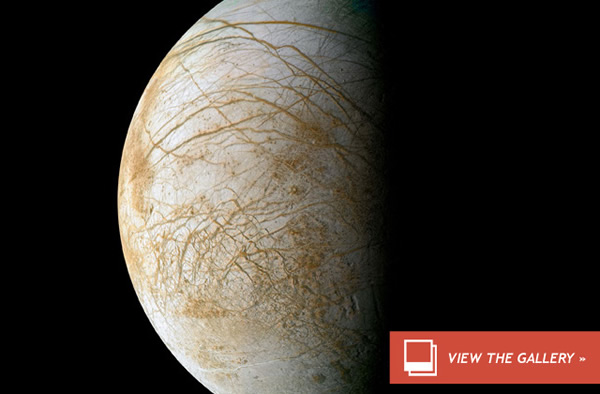Will the Europa Clipper Cruise to Jupiter's Moon?
There are few destinations in the solar system as enticing as Jupiter’s largest moon, Europa. Below its icy crust a liquid water ocean is thought to exist, containing not only the necessary ingredients for life, but, according to scientists, potentially complex organisms. And now, despite a squeezed budget, it looks like NASA has been allocated the seed money for a mission to Europa.
Last week, President Barack Obama signed a resolution that was recently passed by the House and Senate outlining the extent of government funding for a range of science disciplines for the remainder of the fiscal year (until September 2013). But one line of the bill has drawn special interest from planetary scientists. On page 64, the bill (H. R. 933, PDF) says: “$75,000,000 shall be for pre-formulation and/or formulation activities for a mission that meets the science goals outlined for the Jupiter Europa mission in the most recent planetary science decadal survey.”
As noted by Destination: Europa, a group of scientists dedicated to the exploration of the icy Jovian moon, there’s no mention about how the $75 million will be spent, but the fact that it will be used for a “Jupiter Europa mission” is no bad thing.
“It’s much easier to make noise when we are angry than when we are pleased, but we can’t forget to show our appreciation when people go out of their way to support our cause,” Destination: Europa said in a blog on Sunday. The group urged its members to thank the lawmakers at Capitol Hill for their support of Europa science.
Europa recently hit the headlines after planetary scientists, led by Caltech’s Mike Brown, uncovered the presence of magnesium sulfate salt — a.k.a. Epsom salt — on Europa’s surface. Through some clever chemistry detective work, the presence of magnesium sulfate suggests a cycling of Europa’s salty ocean with the surface. This provides a tantalizing clue as the the cycling of nutrients through Europa’s crust, potentially supporting a sub-surface ecosystem.
Will the Europa Clipper Cruise to Jupiter's Moon?
Add that clue to the growing array of hints of the habitability of Europa and it becomes clear that more work needs to be done.
Last year, NASA’s budget was hit by a 20 percent reduction in funding for the planetary sciences. The primary focus, and therefore a chunk of the planetary science budget, is committed to the Mars Program, by which NASA two rovers (Opportunity and Curiosity) and two NASA satellites (Odyssey and the Mars Reconnaissance Orbiter) are managed. The hunt for habitable locations on the Red Planet has therefore relegated the search for other habitable regions of the solar system to the status of “nice idea, but financially impossible right now.”
Although the “Jupiter Europa mission” hasn’t been specified, it seems likely that the Europa Clipper mission has found support in the government. Proposed last year as a cost-effective means of studying the moon, the Clipper would make multiple flybys of Europa while in orbit around Jupiter. A concept that would see a spacecraft in orbit around Europa was rejected as the high-energy environment would likely restrict the mission length to a little over 100 days. A lander concept was considered too premature. The Clipper, however, provides an optimal return of science within the $2 billion budget allocation.
“We briefed (NASA) headquarters on Monday, and they responded very positively,” said David Senske, of NASA’s Jet Propulsion Laboratory in Pasadena, Calif., and Europa Clipper advocate, at the annual fall meeting of the American Geophysical Union in December 2012.
Perhaps the $75 million seed money is a strong sign that NASA headquarters wants to see the Clipper take flight in 2021?
Although this is good news, it’s also a reminder that potentially habitable moons don’t only orbit Jupiter. As argued by Carolyn Porco, planetary scientist and lead of the NASA Cassini imaging team, Europa isn’t the only icy satellite in need of study.
“Cool, except it should be Enceladus!” said Porco in a tweet to Brown on Monday, referring to the Saturnian moon that is known to possess salty liquid water beneath its surface, plus an internal heat source, that generates Enceladus’ famous geysers.
“I’m pantheistic. I’d say yay Enceledus, too. Or Triton. Or Titan. Or Charon. Or a Trojan. Or Io. Or Sedna,” replied Brown.
It goes to show that there are many more targets beyond Mars for the search of potentially habitable environments, let’s hope Europa really will be next on the list.
Apr 1, 2013 09:30 PM ET by Ian O'Neill












